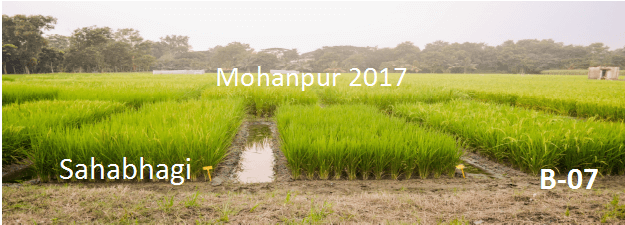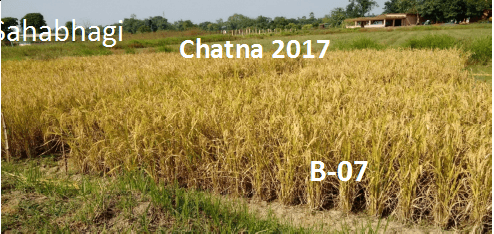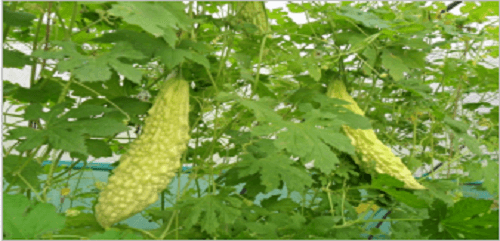
The Regional Nuclear Agriculture Research Centre (RNARC) at Bidhan Chandra Krishi Viswavidyalaya funded by
BRNS-BARC (DAE), Government of India
The Regional Nuclear Agriculture Research Centre (RNARC) is being established mainly to build the capability to carry out basic research work in the broad areas related to various aspects of agriculture, biotechnology and food preservation as listed below. A tripartite Memorandum of Agreement was signed among BRNS, BCKV and DAE to fulfill the objectives on 8th December 2014. In first phase of 4 years, major goal was to develop a series of collaborative R&D projects related to Agricultural improvement of our state vis-à-vis Eastern India which will be reviewed and executed on the basis of recommendation of RTAC Committee of BRNS.
Theme Areas of Interest as Per MoU in Which R&D Studies Were Initiated
- 1. Genetic improvement of crop plants, especially for West Bengal region, through induced mutations, conventional breeding and biotechnological approaches.
- Enhancement of phytomedicines through nuclear intervened molecular breeding.
- Improvement of crop nutrition through radio tracer technique.
- Use of nuclear techniques for food preservation.
- Seed multiplication of improved BARC varieties and distribution of varieties in parts of West Bengal.
- Development of protocol for residual pesticide analysis.
- Improvement of phenolic antioxidant properties of medicinal plants through irradiation in vitro.
- Molecular characterization of mutants.
Initially, BRNS selected four captioned projects along with one central facility with a financial approval of Rs. 6,81,84000. University provided a two storied building for hosting the centre, especially, equipment under the central facility. Government of West Bengal is kind enough to grant a sum of Rs, 32, 00000 for furnishing and modification of the indoor facilities suitable for the centre. Finally, RNARC was inaugurated on auspicious day of September 5 2016 by Padmashree Dr. Sekhar Basu, Chairman, Atomic Energy Commission, Honourable Vice Chancellor, BCKV, Dr. D D Patra and Respected, Mr. P Mazumder, Advisor (Agriculture and allied sector) of Honourable Chief Minister, West Bengal. Currently nine research scholars and six supporting staffs are actively involved in fulfilling the goals of the centre.
Available Equipment Under the Central Facility of RNARC, BCKV
- Gamma Chamber 5000 & Blood Irradiator 2000
- GC-MS (Thermo)
- HPLC System with Fluorescence & ELSD Detector (Waters)
- Water Purification System (Sartorius)
- Gel DOC Including 2D Gel Scanner (UV P)
- UV-VIS spectrophotometer (Eppendorf)
- Weighing Balances (Sartorious)
- Plant Growth Chambers (Phytotron)
- 2D-GEL (Biorad)
- Microscope (Evos Thermo)
- Real time-PCR (Qiagen)
- Hidex 300SL Liquid Scintillation Counter
- Green House
- Refrigerated centrifuge (Heraous)
- Radiation survey meter
- Chlorophyll meter:SPAD-502Plus
- Thermocycler (Proflex Thermo)
- Tissuelizer (Qiagen)
- Deep freezer (-200C) (Vestfrost)
- Jeep-Bolero Mahidra Make
How to access Irradiation Facility/Central Facility of RNARC at BCKV?
RNARC possesses two sources: i) GC5000 and ii) BI2000?
Faculty member/Scientist of any Institute must write a request letter addressed to Centre in Charge, RNARC, BCKV, P.O. Krishiviswavidyalaya, Mohanpur, Nadia PIN 741252, This email address is being protected from spambots. You need JavaScript enabled to view it., explaining the scientific name of the crop/materials, details of dose and purpose/objectives. He will also declare that ‘He will acknowledge the RNARC, BCKV’ for any publication/product/technology arises by using the facility.
Cost for using irradiation facility:
Rs. 500.00/exposure to be paid by draft/cash/chaque in favour of ‘Comptroller, Bidhan Chandra Krishi Viswavidyalaya’. Our bank is UBI. BCKV branch
Caption Project-1: Development of abiotic stress tolerant rice suitable for WB agro-climate with special emphasis to draught and P deficiency’.
Major Outcome:
- One semi-dwarf advance line (B07 in F7) is performing better (15% yield advantage under stress and 30% yield advantage under non stress) than the national check Sahabhagi dhan (released by IRRI) under drought prone acid soil. Second year yield trial is in progress.
- Another semi-dwarf line (F5) with long slender grain is selected by marker assisted pyramiding of two major drought tolerance QTLs and 3 P-deficiency tolerance genes. It requires advancement further two seasons before conducting MET.
- New drought tolerant rice landrace with longer root identified.
Caption Project 2: ˋRadiation technology for Shelf-Life extension of horticultural perishablesˊ.
Outcome:
Shelf life of Himsagar mango increased by 7 more days with 0.5 kGy radiation + HWT (50ºC for 5 min) at ambient temperature than the fruits without any treatment.
A combination of HWT at 55ºC for 5 minutes followed by gamma irradiation at 0.75 kGy retained firmness and extended shelf life up to 35 days without affecting the pulp of Lakshmanbhog mango.
Caption Project 3: Nuclear-intervened molecular breeding and in-vitro culture for increasing yield and phytomedicine production in bitter gourd (Momordica charantia).
Outcome
One roundish-oblong and yellowish-white fruited putative mutant of BG-1346501 (M2-501-100Gy-6) with enhanced β carotene (0.386 mg/100 g) and ascorbic acid (54.67 mg/100 g) and a small fruited putative mutant of Meghna-2 with gynoecious sex form (M2-Meghna-250Gy-20) showed promise.
Fruits with smooth ridge or smooth surface with or without blunt roundish prickles may be linked with medium to high charantin level in the fruits.
Caption Project 4: Increasing use efficiency of nitrogen fertilizer under different ecologies with varied cropping systems and management practices.
Outcome:
- Polymer Sulphur Coated Urea, PSCU (T4) performs better for supply of N to rice only, but Neem coated Urea, NCU (T2) better for wheat and Potato as per ecovery efficiency.
- PSCU performs better than NCU as reflected in Agronomic use efficiency (AEN) both in kharif and boro rice. However, it has no edge over NCU in Wheat and Potato where irrigation requirement is less.
- It also reveals that Transplanting method and SRI method has no significant difference in N-use efficiency.
Other than four caption projects, Following programs are earned by different faculty members from the BRNS.
Project 5. Multi-location yield trial of Trombay Mustard (TM) in West Bengal.
Outcome:
Two entries namely TM-204 and TM-143 were found promising under West Bengal condition and proposal is placed to SVRC for release.
Project 6.
Evaluation of the BARC released Mungbean varieties in different environment of West Bengal.
Project 7.
Evaluation of the BARC released Blackgram and Mustard Varieties for Crop Intensification in West Bengal
Project 8.
Seed production of Trombay groundnut Varieties through farmers’ participatory approach.
Following research projects are recently approved by BRNS
Project 9.
Identification of lentil genotype resistance against Aceto Hydroxy Acid Synthase (AHAS) Inhibitors by Induced Mutation.
Project 10.
Identification of Lentil Genotype resistant against Stemphylium blight by Induced Mutation.
Outreach Program:
- Distribution of easy-to-use soil-carbon analysis kit (sufficient for 600 farmers) and highly efficient Trichoderma strains among the farmers of Bankura, Purulia, Nadia and N-24Pgs.
- Distribution of Trombay released Mungbean Variety, TMB37 varietiy among the farmers in Burdwan, N-24 Pgs.
- RNARC is functioning catalyst for making the idle commercial scale food irradiation unit into functional with help of Ministry of Agriculture, Horticulture, GoW and BARC, Mumbai.
Monitoring and evaluation:
Project monitoring committee (PMC) and Project Review Committee (PRC) are constituted by BARC , mainly comprises of BRNS scientists, and two external members for monitoring and evaluation of all the technical and financial activities of RNARC. PMC meets twice while PRC meets once in each year. Already, PMC meeting held five times and PRC three times since inception of RNARC at the BCKV premises.














